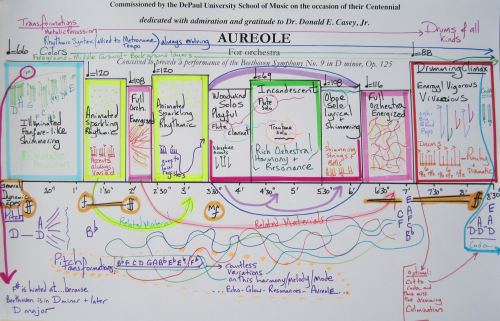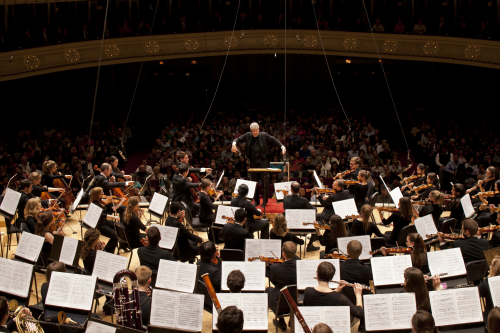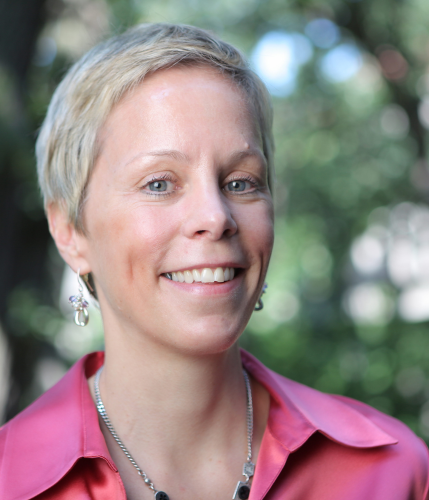May 28, 2013
World premiere of ‘Aureole’ to be performed by DePaul Symphony Orchestra
World premiere of ‘Aureole’ to be performed by DePaul Symphony Orchestra
CHICAGO — Optimistic, bright, sparkling — adjectives used by American composer Augusta Read Thomas to describe “Aureole,” a piece commissioned to mark the DePaul University School of Music’s centennial. The composition, written by Thomas as a prelude to the majestic Beethoven Ninth Symphony, will have its world premiere May 29 in Chicago in Orchestra Hall at Symphony Center. Performed by the DePaul Symphony Orchestra, the concert will be conducted by the distinguished Cliff Colnot. The title, “Aureole,” makes reference to an encircling ring of light, a halo around the head of a sacred personage or saint.
Thomas, a prolific and illustrious composer, admits to having a natural musicality — hearing pitches clearly and working at composition since she was 15. But her music is incredibly nuanced, detailed, “like fine lace,” she said. “Every single note has an articulation, a dynamic, an adjective, a tempo and inner life to it.”
When she was approached by Donald E. Casey, dean of DePaul’s School of Music, to write a piece that would relate to or be a good opener for Beethoven’s Ninth, Thomas said she was “humbled and very touched to have the opportunity to write for this very special occasion for DePaul University, for the centennial, for the orchestra, which I know is fantastic, for one of my closest friends, Cliff Colnot the conductor.
“I was very humbled and also a little terrified because it’s a tough assignment to have to relate to one of the greatest pieces of history,” said Thomas, a professor of composition at the University of Chicago.
After playing first with the idea of taking “one little phrase” from Beethoven’s Ninth — “four bars or two bars or something, and making a huge spinout from that” — Thomas instead started thinking how could she make a relation to the entire Beethoven piece, viewing the symphony as a whole object.
“That’s quite difficult,” said the composer. “What kind of mapping could I make toward it or leaning toward it or spinning out from it; or perfume that came to my mind from its fragrances.”
During the nearly six-month process, Thomas decided to approach it in a big way, making strong reference to Beethoven’s tonal centers.
“And yet, between those tonal centers, inventing completely original work. It was then that I started to have a picture of what the piece might be,” Thomas said. “I started improvising at the piano and came up with the opening, which starts on a D (note).”
“Thomas’ use of both tonal centers and intervals crucial to the Ninth Symphony is a musical aureole around (Beethoven’s) work,” said Michael Lewanski, an assistant professor and ensemble conductor at DePaul’s School of Music.
“Fanfare-like repeated notes in the trumpets and violins, marked ‘blazing,’ add an A shortly thereafter, creating the interval of a fifth — the open-sounding sonority with which Beethoven’s symphony also begins,” wrote Lewanski in the concert’s Program Notes. “The final chord of the work is, again, fifths: D, A, and E — the very first and the very last notes of Beethoven’s Ninth Symphony. An ‘encircling ring of light’ indeed.”
In composing “Aureole,” which is between eight-to-nine minutes in length, Thomas also was thinking about the orchestra — the young musicians who would be playing it. “I wanted it to be a piece that would give them solos, little features, micro solos,” she said. “So there’s an oboe solo, a flute solo, a clarinet solo, a trombone solo, a lot of good trumpet solos, solos for the groups or individual. And then kind of a shimmering string sound and there’s a huge episode for the four percussionists playing a variety of drums.”
Thomas has worked with the DePaul Symphony Orchestra and its conductor in the past. “I’m excited to work with them again because they’re exceptional. And, university orchestras give wonderful premieres; the conductor Cliff Colnot is fabulous. I love the way he conducts my music and thankfully he always plays the notated tempos.
“I celebrate the musicians and the conductor because as I wrote this piece I knew who would be conducting and who would be playing, so I really had that in my mind’s eye as I wrote every note,” she said. “These young musicians will bring a brand new piece of music to life with all their energy and vigor.”
The 37th annual spring concert of the DePaul Symphony Orchestra and Chorus “is particularly celebratory as it involves nearly 200 DePaul students, four faculty soloists, one of the best-known and greatest symphonies ever written, as well as the very special work commissioned for the occasion,” said Casey, dean of the School of Music. “The centennial of the school is a milestone and this will be a spectacular performance.”
The conductor, Colnot, “brings the DePaul Symphony Orchestra to life,” Casey said. “He built the students into a true ensemble and brings distinction to the university.”
The DePaul Chorus, prepared by Steven Grives, will join the students of the orchestra to perform Beethoven’s Ninth with esteemed faculty soloists Elizabeth Byrne, Jane Bunnell, Michael Sylvester and Marc Embree.
The School of Music was established at DePaul University in 1912 with the noble mission of educating promising young musicians. It now boasts one of the strongest collegiate orchestras in America.
Additional information about the school, which is located on DePaul’s Lincoln Park Campus in Chicago, is at http://music.depaul.edu or 773-325-7260. More information about the May 29 concert, which begins at 8 p.m. in Orchestra Hall at Symphony Center, 220 S. Michigan Ave., is at http://bit.ly/ZRJIWy.

A “mapping” of “Aureole” by composer Augusta Read Thomas illustrates the colorful music written to precede a performance of Beethoven’s Ninth Symphony. “Shimmering, sparkling, energized and incandescent” are adjectives used by Thomas to describe the sounds. (Sketch courtesy of Augusta Read Thomas)

The DePaul Symphony Orchestra and Chorus will perform Beethoven's Ninth Symphony and a specially commissioned orchestral overture written by Chicago composer Augusta Read Thomas on May 29 in Orchestra Hall at Symphony Center in Downtown Chicago. The concert, under the direction of conductor Cliff Colnot, showcases the talent of nearly 200 students and faculty members from DePaul University and is part of this year's centennial celebration of the School of Music. (DePaul University/Doug McGoldrick)

American composer Augusta Read Thomas was commissioned to write a piece of music to mark the DePaul University School of Music’s centennial. Her composition, “Aureole,” was written as a prelude to the majestic Beethoven Ninth Symphony. It will have its world premiere May 29 in Chicago. (Photo by Jason Smith)
